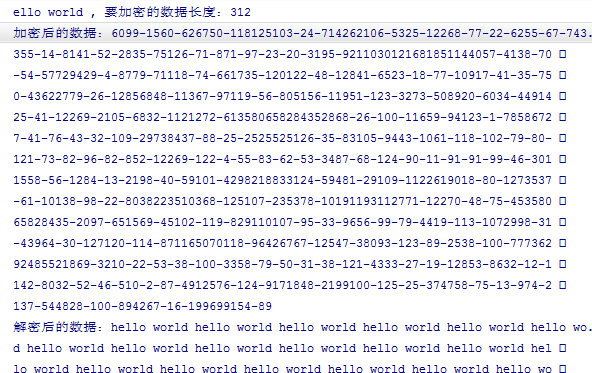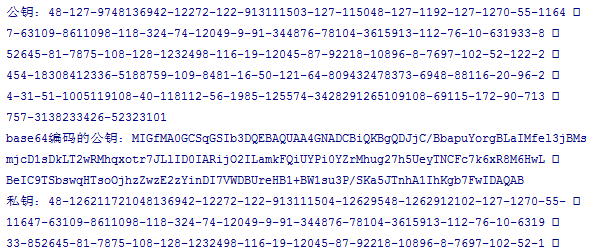溫馨提示×
您好,登錄后才能下訂單哦!
點擊 登錄注冊 即表示同意《億速云用戶服務條款》
您好,登錄后才能下訂單哦!
這期內容當中小編將會給大家帶來有關怎么在Android中利用RSA算法進行加密和解密,文章內容豐富且以專業的角度為大家分析和敘述,閱讀完這篇文章希望大家可以有所收獲。
一、公鑰加密和私鑰解密
/**RSA算法*/
public static final String RSA = "RSA";
/**加密方式,android的*/
// public static final String TRANSFORMATION = "RSA/None/NoPadding";
/**加密方式,標準jdk的*/
public static final String TRANSFORMATION = "RSA/None/PKCS1Padding";
/** 使用公鑰加密 */
public static byte[] encryptByPublicKey(byte[] data, byte[] publicKey) throws Exception {
// 得到公鑰對象
X509EncodedKeySpec keySpec = new X509EncodedKeySpec(publicKey);
KeyFactory keyFactory = KeyFactory.getInstance("RSA");
PublicKey pubKey = keyFactory.generatePublic(keySpec);
// 加密數據
Cipher cp = Cipher.getInstance(TRANSFORMATION);
cp.init(Cipher.ENCRYPT_MODE, pubKey);
return cp.doFinal(data);
}
/** 使用私鑰解密 */
public static byte[] decryptByPrivateKey(byte[] encrypted, byte[] privateKey) throws Exception {
// 得到私鑰對象
PKCS8EncodedKeySpec keySpec = new PKCS8EncodedKeySpec(privateKey);
KeyFactory kf = KeyFactory.getInstance(RSA);
PrivateKey keyPrivate = kf.generatePrivate(keySpec);
// 解密數據
Cipher cp = Cipher.getInstance(TRANSFORMATION);
cp.init(Cipher.DECRYPT_MODE, keyPrivate);
byte[] arr = cp.doFinal(encrypted);
return arr;
}1.data是要加密的數據,如果是字符串則getBytes。publicKey是公鑰,privateKey是私鑰。自定義密鑰對測試
String data = "hello world";
try {
int keyLength = 1024;
//生成密鑰對
KeyPair keyPair = RSAUtils.generateRSAKeyPair(keyLength);
//獲取公鑰
byte[] publicKey = RSAUtils.getPublicKey(keyPair);
//獲取私鑰
byte[] privateKey = RSAUtils.getPrivateKey(keyPair);
//用公鑰加密
byte[] encrypt = RSAUtils.encryptByPublicKey(data.getBytes(), publicKey);
Log.d("TAG", "加密后的數據:" + StringUtils.byteArrayToString(encrypt));
//用私鑰解密
byte[] decrypt = RSAUtils.decryptByPrivateKey(encrypt, privateKey);
Log.d("TAG", "解密后的數據:" + new String(decrypt, "utf-8"));
} catch (Exception e) {
e.printStackTrace();
}
2.從文件中讀取公鑰

String data = "hello world";
//讀取公鑰文件
String publicKeyString = IOUtils.readAssetsFile(this, "rsa_public_key.pem");
//base64解碼
byte[] publicKey = Base64Utils.decodeToBytes(publicKeyString);
try {
//加密
byte[] encrypt = RSAUtils.encryptByPublicKey(data.getBytes(), publicKey);
Log.d("TAG", "加密后的數據:" + StringUtils.byteArrayToString(encrypt));
// //讀取私鑰文件
// String privateKeyString = IOUtils.readAssetsFile(this, "rsa_private_key.pem");
// //base64解碼
// byte[] privateKey = Base64Utils.decodeToBytes(privateKeyString);
// //解密
// byte[] decrypt = RSAUtils.decryptByPrivateKey(encrypt, privateKey);
// Log.d("TAG", "解密后的數據:" + new String(decrypt, "utf-8"));
} catch (Exception e) {
e.printStackTrace();
}二、公鑰分段加密和私鑰分段解密
當加密的數據過長時,會出現javax.crypto.IllegalBlockSizeException: Data must not be longer than 117 bytes的異常。rsa算法規定一次加密的數據不能超過生成密鑰對時的keyLength/8-11,keyLength一般是1024個字節,則加密的數據不能超過117個字節
/**秘鑰默認長度*/
public static final int DEFAULT_KEY_SIZE = 1024;
/**加密的數據最大的字節數,即117個字節*/
public static final int DEFAULT_BUFFERSIZE = (DEFAULT_KEY_SIZE / 8) - 11;
/**當加密的數據超過DEFAULT_BUFFERSIZE,則使用分段加密*/
public static final byte[] DEFAULT_SPLIT = "#PART#".getBytes();
/** 使用公鑰分段加密 */
public static byte[] encryptByPublicKeyForSpilt(byte[] data, byte[] publicKey) throws Exception{
int dataLen = data.length;
if (dataLen <= DEFAULT_BUFFERSIZE) {
return encryptByPublicKey(data, publicKey);
}
List<Byte> allBytes = new ArrayList<Byte>(2048);
int bufIndex = 0;
int subDataLoop = 0;
byte[] buf = new byte[DEFAULT_BUFFERSIZE];
for (int i = 0; i < dataLen; i++) {
buf[bufIndex] = data[i];
if (++bufIndex == DEFAULT_BUFFERSIZE || i == dataLen - 1) {
subDataLoop++;
if (subDataLoop != 1) {
for (byte b : DEFAULT_SPLIT) {
allBytes.add(b);
}
}
byte[] encryptBytes = encryptByPublicKey(buf, publicKey);
for (byte b : encryptBytes) {
allBytes.add(b);
}
bufIndex = 0;
if (i == dataLen - 1) {
buf = null;
} else {
buf = new byte[Math
.min(DEFAULT_BUFFERSIZE, dataLen - i - 1)];
}
}
}
byte[] bytes = new byte[allBytes.size()];
int i = 0;
for (Byte b : allBytes) {
bytes[i++] = b.byteValue();
}
return bytes;
}
/** 使用私鑰分段解密 */
public static byte[] decryptByPrivateKeyForSpilt(byte[] encrypted, byte[] privateKey) throws Exception {
int splitLen = DEFAULT_SPLIT.length;
if (splitLen <= 0) {
return decryptByPrivateKey(encrypted, privateKey);
}
int dataLen = encrypted.length;
List<Byte> allBytes = new ArrayList<Byte>(1024);
int latestStartIndex = 0;
for (int i = 0; i < dataLen; i++) {
byte bt = encrypted[i];
boolean isMatchSplit = false;
if (i == dataLen - 1) {
// 到data的最后了
byte[] part = new byte[dataLen - latestStartIndex];
System.arraycopy(encrypted, latestStartIndex, part, 0, part.length);
byte[] decryptPart = decryptByPrivateKey(part, privateKey);
for (byte b : decryptPart) {
allBytes.add(b);
}
latestStartIndex = i + splitLen;
i = latestStartIndex - 1;
} else if (bt == DEFAULT_SPLIT[0]) {
// 這個是以split[0]開頭
if (splitLen > 1) {
if (i + splitLen < dataLen) {
// 沒有超出data的范圍
for (int j = 1; j < splitLen; j++) {
if (DEFAULT_SPLIT[j] != encrypted[i + j]) {
break;
}
if (j == splitLen - 1) {
// 驗證到split的最后一位,都沒有break,則表明已經確認是split段
isMatchSplit = true;
}
}
}
} else {
// split只有一位,則已經匹配了
isMatchSplit = true;
}
}
if (isMatchSplit) {
byte[] part = new byte[i - latestStartIndex];
System.arraycopy(encrypted, latestStartIndex, part, 0, part.length);
byte[] decryptPart = decryptByPrivateKey(part, privateKey);
for (byte b : decryptPart) {
allBytes.add(b);
}
latestStartIndex = i + splitLen;
i = latestStartIndex - 1;
}
}
byte[] bytes = new byte[allBytes.size()];
int i = 0;
for (Byte b : allBytes) {
bytes[i++] = b.byteValue();
}
return bytes;
}測試分段加密和解密
String data = "hello world hello world hello world hello world hello world hello world hello world hello world " +
"hello world hello world hello world hello world hello world hello world hello world hello world hello world " +
"hello world hello world hello world hello world hello world hello world hello world hello world hello world ";
Log.d("TAG", "要加密的數據:" + data + ", 要加密的數據長度:" + data.length());
try {
//分段加密
byte[] encrypt = RSAUtils.encryptByPublicKeyForSpilt(data.getBytes(), publicKey);
Log.d("TAG", "加密后的數據:" + StringUtils.byteArrayToString(encrypt));
//分段解密
byte[] decrypt = RSAUtils.decryptByPrivateKeyForSpilt(encrypt, privateKey);
Log.d("TAG", "解密后的數據:" + new String(decrypt, "utf-8"));
} catch (Exception e) {
e.printStackTrace();
}三、生成密鑰對

/** 生成密鑰對,即公鑰和私鑰。key長度是512-2048,一般為1024 */
public static KeyPair generateRSAKeyPair(int keyLength) throws NoSuchAlgorithmException {
KeyPairGenerator kpg = KeyPairGenerator.getInstance(RSA);
kpg.initialize(keyLength);
return kpg.genKeyPair();
}
/** 獲取公鑰,打印為48-12613448136942-12272-122-913111503-126115048-12...等等一長串用-拼接的數字 */
public static byte[] getPublicKey(KeyPair keyPair) {
RSAPublicKey rsaPublicKey = (RSAPublicKey) keyPair.getPublic();
return rsaPublicKey.getEncoded();
}
/** 獲取私鑰,同上 */
public static byte[] getPrivateKey(KeyPair keyPair) {
RSAPrivateKey rsaPrivateKey = (RSAPrivateKey) keyPair.getPrivate();
return rsaPrivateKey.getEncoded();
}生成公鑰和私鑰后,用base64編碼
int keyLength = 1024;
try {
//生成密鑰對
KeyPair keyPair = RSAUtils.generateRSAKeyPair(keyLength);
//獲取公鑰
byte[] publicKey = RSAUtils.getPublicKey(keyPair);
Log.d("TAG", "公鑰:" + StringUtils.byteArrayToString(publicKey));
//公鑰用base64編碼
String encodePublic = Base64Utils.encodeToString(publicKey);
Log.d("TAG", "base64編碼的公鑰:" + encodePublic);
//獲取私鑰
byte[] privateKey = RSAUtils.getPrivateKey(keyPair);
Log.d("TAG", "私鑰:" + StringUtils.byteArrayToString(privateKey));
//私鑰用base64編碼
String encodePrivate = Base64Utils.encodeToString(privateKey);
Log.d("TAG", "base64編碼的私鑰:" + encodePrivate);
} catch (NoSuchAlgorithmException e) {
e.printStackTrace();
}
上述就是小編為大家分享的怎么在Android中利用RSA算法進行加密和解密了,如果剛好有類似的疑惑,不妨參照上述分析進行理解。如果想知道更多相關知識,歡迎關注億速云行業資訊頻道。
免責聲明:本站發布的內容(圖片、視頻和文字)以原創、轉載和分享為主,文章觀點不代表本網站立場,如果涉及侵權請聯系站長郵箱:is@yisu.com進行舉報,并提供相關證據,一經查實,將立刻刪除涉嫌侵權內容。